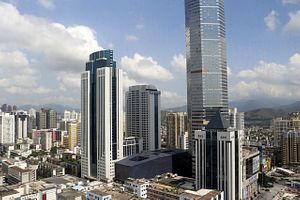China’s State Council and the Central Committee of the Communist Party of China issued a new guideline earlier this week outlining an ambitious plan for the future of Shenzhen, a major city in southeast China’s Guangzhou province that links Hong Kong to the mainland.
The plan sets out plans to transform Shenzhen into a pilot area demonstrating “socialism with Chinese characteristics” by making it a leading city in the world in terms of economic might and development quality, specifically focusing on research and development, industrial innovation, emerging industries, public services, and ecological environment.
This individual plan for Shenzhen fits within a larger strategy to develop a Greater Bay Area that would integrate the Hong Kong and Macau Special Administrative Regions with nine other municipalities in the surrounding region in Guangdong province (Dongguan, Foshan, Guangzhou, Huizhou, Jiangmen, Shenzhen, Zhaoqing, Zhongshan, and Zhuhai), which account for approximately 12 percent of China’s national GDP and a combined population of 70 million people. The Greater Bay Area initiative, whose outline was released in early 2019, is designed to create a mega-hub in the Pearl River Delta that will be a vehicle for “breaking new ground” on economic growth, reforms, and innovation and take the practice of “one country, two systems” a step further, though how the latter will be achieved remains largely unclear. The more tangible developmental areas include boosting infrastructure connectivity, cooperating and participating in China’s Belt and Road Initiative, focusing on innovation and technology, and building a modern industrial system.
The plan also delineates that the Greater Bay Area will “enable compatriots in Hong Kong and Macau to share with the people in the motherland both the historic responsibility of national rejuvenation and the pride of a strong and prosperous motherland.” This is perhaps a not-so-subtle indication of Beijing’s intent to emphasize the centrality of mainland China and to dilute the disparity of power and influence between Hong Kong and other mainland economic centers and metropolises.
Shenzhen has a population of more than 12 million people and was the site of the mainland’s first special economic zone. Its status helped facilitate growth fueled by significant waves of foreign investment. Since the 1980s and 1990s, Shenzhen’s economy has shifted to focus on high-tech, financial, and logistics industries, while the city has also become a hot destination for shoppers. Separately, Chinese technology giants like Huawei and Tencent and telecommunications company ZTE house their headquarters in Shenzhen. The city is also the third largest and busiest container port in the world, while it ranked 14th in the 2019 Global Financial Centers Index (Hong Kong took the third spot, by comparison).
Shenzhen’s economy surpassed Hong Kong’s for the first time in 2018, reaching HK$2.87 trillion compared to Hong Kong’s HK$2.85 trillion in the same year. The starker difference remains the disparity in the growth rates of the two Pearl River Delta metropolises, with Shenzhen’s GDP notching a 7.6 percent growth rate, while Hong Kong’s economy rose by just 3 percent. More recently, Hong Kong’s financial secretary Paul Chan Mo-po cut the city’s growth forecast for 2019 to somewhere between 0 to 1 percent.
These economic dynamics are shifting as political tensions between the mainland and Hong Kong have been simmering throughout the summer. What started as protests in opposition to an amendment to Hong Kong’s extradition law has ripened into a broader movement against police brutality, the dissonance between the Hong Kong government and portions of the population, and Beijing’s increasing influence in the financial hub.
Editorials in Chinese press have already praised the potential of Shenzhen to outperform and surpass Hong Kong vis-a-vis China’s economic development, suggesting that Hong Kong’s political turmoil are threatening its “irreplaceability” and relevance in the mainland’s economic development strategy.
Economics and politics tend to be presented as distinct elements of governance, but they are nevertheless highly linked, particularly in a one-party country like the People’s Republic of China. Beijing’s economic plans are closely related to its political objectives, maintenance of legitimacy, and political survival.
Of course, the introduction of new economic plans that affect Hong Kong is not the only tool China is employing to try and address Hong Kong’s latest political unrest: recent reports have speculated about whether China will deploy its military and uncovered a social media influence campaign. Chinese military and armed police forces have also conducted riot exercises just across the border in Shenzhen in recent weeks, demonstrating and posturing strength.
Still, these other examples remain short-term tactics, while doubling down on cities like Shenzhen and others in the Pearl River Delta may carry longer term consequences for how Hong Kong fits into Beijing’s strategic vision for building up mainland China’s power.

































